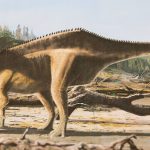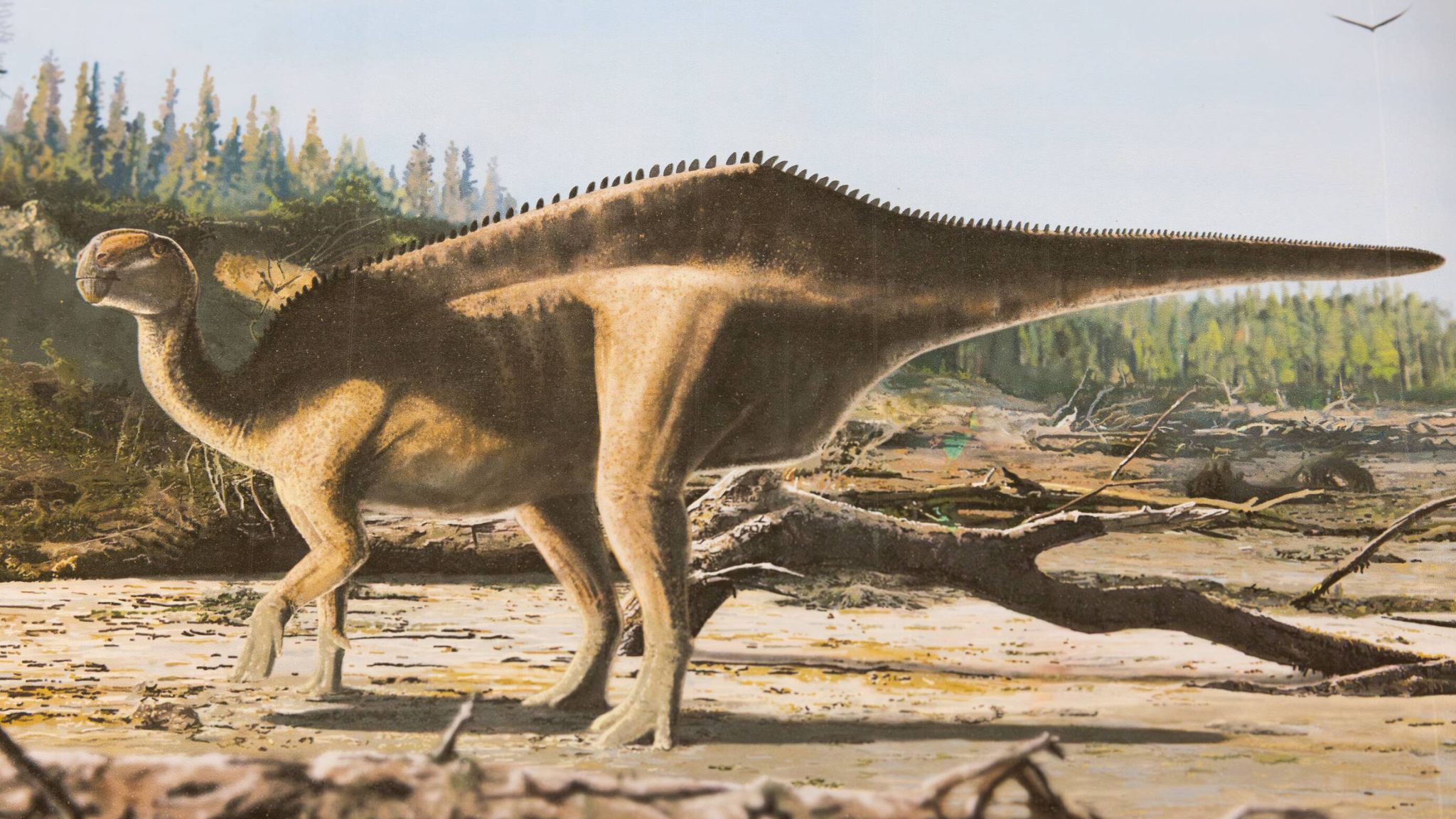Imagine a dusty drawer in a museum, filled with fossilized bones collected decades ago. They’ve been sitting quietly, forgotten by most. But one day, a researcher takes a closer look—and suddenly, a new chapter of Earth’s history is revealed.
This is exactly what happened on the Isle of Wight, England, where scientists recently discovered a new species of dinosaur—one that roamed the planet 125 million years ago. But there’s a twist: this dinosaur carries a name inspired by modern sailing history.
Meet Istiorachis macarthurae, a sail-backed herbivore named in honor of Dame Ellen MacArthur, the record-breaking British sailor who circumnavigated the globe solo at lightning speed. This remarkable fusion of prehistory and modern achievement shows how scientific discoveries often celebrate not just nature’s wonders but also human triumphs.
In this article, we’ll dive deep into the discovery, anatomy, ecosystem, cultural significance, and expert insights surrounding this incredible find.
The Discovery: A Forgotten Fossil That Changed History
The story begins in the collections of the Dinosaur Isle Museum on the Isle of Wight. For years, paleontologists believed the fossils belonged to a known species, likely an iguanodontian dinosaur already identified in the region. But when Dr. Jeremy Lockwood, a dedicated researcher from the University of Portsmouth, re-examined the bones, he noticed something unusual.
The vertebrae displayed elongated neural spines—structures extending upward from the backbone that formed a striking sail-like structure along the dinosaur’s back and tail. These unusual adaptations hinted that the specimen belonged to a completely new species.
It was a breakthrough moment. Not only had scientists discovered a never-before-seen dinosaur, but they also gained new insights into the evolutionary diversity of herbivorous dinosaurs during the Early Cretaceous period.
Naming the Sail-Backed Wonder
The new species was officially named Istiorachis macarthurae. The name carries deep meaning:
“Istio” – derived from Greek, meaning “sail.”
“Rachis” – meaning “spine,” referring to the dinosaur’s dramatic back structure.
“Macarthurae” – honoring Dame Ellen MacArthur, the Isle of Wight-born sailor who famously completed the fastest solo, nonstop circumnavigation of the globe in 2005.
This naming isn’t just symbolic—it reflects a celebration of exploration. Just as MacArthur conquered the oceans, this dinosaur’s sail evokes images of ancient seas and winds, making the connection both poetic and scientifically significant.
Anatomy & Physical Features: A Dinosaur With a Natural Sail
Size and Structure
Istiorachis macarthurae was roughly the size of an American bison. Scientists estimate it measured around 2 meters in height and weighed close to 1 tonne (1,000 kilograms). As an iguanodontian, it walked primarily on four legs but could rear up on two when necessary—perfect for browsing tall vegetation.
The Iconic Sail
The most defining feature of this dinosaur is, of course, its dorsal sail—a row of elongated neural spines extending from the back into the tail. But why would an animal evolve such a structure? Paleontologists suggest a few possible functions:
Visual Displays for Mating – Like peacocks and other animals, the sail may have been used to attract potential mates.
Species Recognition – In environments filled with multiple iguanodontian species, the sail could have acted as a visual identifier.
Thermoregulation – Some researchers believe the sail might have helped control body temperature by absorbing or dissipating heat.
While the exact purpose remains debated, scientists lean toward the theory that the sail played a key role in social signaling, showcasing evolutionary experimentation during this era.
Life on the Isle of Wight: A Snapshot of the Early Cretaceous
An Ancient Ecosystem
Around 125 million years ago, the Isle of Wight was a very different place. Instead of quiet coastal towns, it was home to lush forests, wide floodplains, and winding rivers. It hosted a diverse range of dinosaurs, from armored ankylosaurs and herbivorous iguanodontians to small predatory theropods related to Velociraptor.
This ecosystem was dynamic, teeming with life, and Istiorachis macarthurae would have likely lived in herds, grazing on ferns, cycads, and other low-lying vegetation.
Expanding Dinosaur Diversity
For decades, paleontologists believed the Isle of Wight’s iguanodontians consisted of just two known species. But over the past five years, researchers—including Lockwood—have uncovered evidence of four additional species, including Istiorachis. This quadrupling of diversity offers new insights into how dinosaurs adapted and competed in shared environments.
Expert Insights: Unlocking Hidden Secrets
Dr. Jeremy Lockwood, who led the study, described the discovery as “a reminder of the treasures still hidden in museum collections.” He explained that fossils once thought to belong to familiar species turned out to represent something entirely new.
Similarly, Prof. Susannah Maidment from the Natural History Museum praised the find, highlighting that it underscores the value of re-examining existing specimens with fresh perspectives and modern tools.
Their work demonstrates an important lesson in paleontology: sometimes groundbreaking discoveries are hiding in plain sight.
Why This Discovery Matters
A Window Into Evolution
The sail-backed structure of Istiorachis highlights just how experimental evolution can be. While the structure may have been risky—making the dinosaur more vulnerable to predators—it likely provided significant advantages in mating success and social interaction.
Honoring Human Exploration
By naming the dinosaur after Ellen MacArthur, scientists created a symbolic bridge between natural history and human achievement. It reflects a shared spirit of discovery—one through uncharted seas, the other through deep time.
The Power of Museum Research
This discovery also underscores the importance of museum collections. While field digs uncover new fossils, hidden gems often lie within drawers and cabinets, waiting for someone with fresh eyes and curiosity to uncover their secrets.
FAQs
What is Istiorachis macarthurae?
A newly discovered species of sail-backed iguanodontian dinosaur from the Early Cretaceous period.
Why is the dinosaur named after Ellen MacArthur?
To honor the legendary sailor’s historic solo circumnavigation and her connection to the Isle of Wight, where the fossils were found.
How old are the fossils?
Approximately 125 million years old, dating back to the Early Cretaceous.
How large was this dinosaur?
Around 2 meters tall and weighing roughly 1 tonne—similar in size to an American bison.
What was the sail used for?
Scientists believe it was primarily for visual display, possibly to attract mates or identify members of the same species.
Where were the fossils discovered?
In the Dinosaur Isle Museum collection on the Isle of Wight, England.
Why was this discovery significant?
It expands our understanding of dinosaur diversity and highlights how revisiting old fossils can lead to groundbreaking discoveries.
Conclusion:
The story of Istiorachis macarthurae is more than just a paleontological breakthrough. It’s a reminder that our planet still holds untold secrets—some buried in the ground, others quietly waiting in museum drawers.
By combining deep-time discovery with modern-day heroism, this naming celebrates two powerful forces: evolutionary creativity and human ambition. Just as Ellen MacArthur’s sails carried her across the world’s oceans, this dinosaur’s sail carried its legacy across 125 million years of history.
Science thrives when we connect the past and present, honoring not only the creatures that once ruled our planet but also the explorers—on land, sea, and in laboratories—who reveal their stories.














